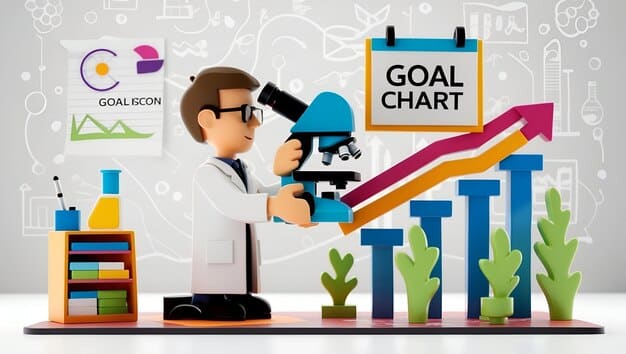Revised STEM Curriculum: Preparing US Students for Future Careers

Revised curriculum standards for STEM education are crucial for equipping students with the necessary skills and knowledge for future careers in science, technology, engineering, and mathematics, ensuring the US remains competitive in a global economy.
The landscape of education is constantly evolving, and with it, the need to adapt curriculum standards to better prepare students for the demands of the future workforce. This is especially true in the fields of science, technology, engineering, and mathematics (STEM), where innovation and advancement are rapidly transforming industries. Revised curriculum standards for STEM education are vital for ensuring that students in the US are equipped with the necessary skills and knowledge to thrive in these dynamic fields.
The Imperative of STEM Education in the 21st Century
STEM education has emerged as a critical component of modern education systems globally, recognizing its pivotal role in fostering innovation, driving economic growth, and addressing complex societal challenges. Preparing students for future careers hinges significantly on how we approach STEM education today.
Economic Growth and Innovation
STEM fields are undeniably the driving force behind technological advancements and economic prosperity. A robust STEM education system equips students with the skills needed to innovate, create, and solve problems, directly impacting the competitiveness of a nation.
Addressing Global Challenges
Many of the most pressing global challenges, such as climate change, healthcare, and sustainable energy, require STEM expertise to develop viable solutions. By fostering a strong foundation in these disciplines, we prepare the next generation to tackle these challenges head-on.

Investing in STEM education is not merely an educational choice, but a strategic imperative for national prosperity and global leadership. Without a well-prepared STEM workforce, the US risks falling behind in the global race for innovation and economic competitiveness.
Key Elements of Revised STEM Curriculum Standards
The revision of STEM curriculum standards involves a multifaceted approach that encompasses pedagogy, content, and assessment methods, all aimed at cultivating a deeper and more relevant understanding of STEM disciplines for students.
Integration of Interdisciplinary Learning
Modern STEM education emphasizes the interconnectedness of these fields, promoting interdisciplinary learning where students understand how science, technology, engineering, and mathematics integrate to solve real-world problems.
Focus on Computational Thinking
Computational thinking, which involves problem-solving using algorithms, data analysis, and automation, is becoming increasingly essential. Revised standards incorporate computational thinking across all STEM subjects, empowering students to approach problem-solving from a computational perspective.
Emphasis on Experiential Learning
Hands-on, experiential learning is a cornerstone of revised STEM standards, encouraging students to engage directly with scientific phenomena through experiments, projects, and simulations. This approach fosters a deeper understanding and retention of concepts.
- Project-Based Learning: Students engage in extended projects that require them to apply STEM knowledge to solve real-world problems.
- Inquiry-Based Learning: Students explore questions and conduct investigations, fostering critical thinking and problem-solving skills.
- Real-World Applications: Connecting STEM concepts to real-world scenarios makes learning more relevant and engaging for students.
A curriculum that incorporates these key elements aims to move beyond traditional rote learning, transforming STEM education into a dynamic, engaging, and relevant experience for all students.
Impact on Student Outcomes and Future Readiness
The ultimate goal of revising STEM curriculum standards is to improve student outcomes and enhance their readiness for future careers. These changes can have a profound impact on students’ academic and professional trajectories.
Improved Problem-Solving Skills
By focusing on interdisciplinary learning and hands-on experience, the revised standards cultivate critical thinking and problem-solving skills that are essential in any STEM field.
Increased Interest in STEM Careers
Engaging, relevant, and practical STEM education can spark an interest in STEM careers that might not have otherwise existed. By showcasing the real-world applications of STEM knowledge, students are more likely to pursue these fields.
Enhanced College and Career Preparedness
Students who have been educated under revised STEM standards are better prepared for the rigor of college-level coursework and the demands of modern workplaces.

The impact on student outcomes is undeniable. Students educated under revised STEM curriculum standards are more likely to be engaged, skilled, and prepared for the challenges and opportunities of the future.
Challenges in Implementing Revised Standards
While the benefits of revised STEM curriculum standards are clear, their implementation is not without challenges. Schools, educators, and policymakers must address several obstacles to ensure successful adoption of these standards.
Professional Development for Teachers
Teachers require ongoing professional development to effectively teach revised STEM standards. They need training in new pedagogical approaches, interdisciplinary integration, and the use of technology in the classroom.
Access to Resources and Technology
Many schools, particularly those in underserved communities, lack access to the resources and technology needed to support revised STEM standards. Addressing this inequity is crucial for ensuring that all students have the opportunity to succeed.
Stakeholder Buy-In
Effective implementation requires buy-in from all stakeholders, including teachers, administrators, parents, and policymakers. Clear communication and collaboration are essential for achieving this.
Overcoming these challenges requires a coordinated effort at all levels of the education system. With adequate resources, support, and collaboration, these obstacles can be surmounted, paving the way for successful implementation of revised STEM standards.
The Role of Technology in Modern STEM Education
Technology plays a pivotal role in modern STEM education, serving as both a subject of study and a tool for learning. Integrating technology effectively into the curriculum can enhance engagement, accessibility, and preparedness.
Digital Learning Platforms
Digital learning platforms offer interactive and adaptive learning experiences that can cater to individual student needs. These platforms provide access to a wealth of resources, simulations, and virtual labs.
Coding and Robotics
Coding and robotics are becoming increasingly important components of STEM education, teaching students how to design, build, and program machines and software.
Data Analytics and Visualization
Teaching students how to analyze and visualize data is essential for interpreting information and making informed decisions. Technology provides the tools for students to collect, analyze, and present data effectively.
Leveraging technology in STEM education can transform the learning experience, making it more engaging, relevant, and effective for all students. By embracing technology, educators can better prepare students for the challenges and opportunities of the future.
Future Trends and Innovations in STEM Education
As technology and society continue to evolve, so too will STEM education. Several emerging trends and innovations promise to shape the future of STEM learning, further enhancing student outcomes and career readiness.
Personalized Learning
Personalized learning tailors education to the individual needs and preferences of each student, using data and technology to adapt the curriculum and pace of learning.
Artificial Intelligence (AI) in Education
AI is poised to revolutionize STEM education, offering personalized tutoring, automated assessment, and intelligent learning platforms that can adapt to student progress.
Virtual and Augmented Reality (VR/AR)
VR and AR technologies offer immersive learning experiences that can bring STEM concepts to life, allowing students to explore virtual labs, dissect models, and simulate complex systems.
The future of STEM education is bright, with innovations promising to transform the learning experience and better prepare students for the demands of the future workforce. By embracing these trends, educators can ensure that STEM education remains engaging, relevant, and effective for all students.
| Key Point | Brief Description |
|---|---|
| 🚀 STEM Importance | STEM drives innovation and economic growth. |
| 💡 Key Elements | Interdisciplinary, computational thinking and experiential learning. |
| 🍎 Student Impact | Improved skills, interest and preparedness for careers. |
| 🤖 Tech’s Role | Technology enhances engagement and accessibility in STEM education. |
Frequently Asked Questions (FAQ)
▼
Revised standards ensure students gain relevant skills, preparing them for future STEM careers and technological advancements, vital to US competitiveness.
▼
Key elements include interdisciplinary approaches, computational thinking, experiential learning, and real-world applications, emphasizing hands-on experiences.
▼
Revised standards lead to better problem-solving skills, increased STEM career interest, and enhanced preparedness for college and future employment.
▼
Challenges include teacher training, resource access, and stakeholder buy-in, requiring collaborative solutions to overcome implementation obstacles.
▼
Future trends include personalized learning, AI-driven education, and VR/AR technologies, promising more engaging and customized STEM educational experiences.
Conclusion
In conclusion, revised curriculum standards for STEM education: Preparing students for future careers are crucial for ensuring that the US remains at the forefront of innovation and economic growth. By focusing on interdisciplinary learning, computational thinking, experiential learning, and the integration of technology, these standards have the potential to transform STEM education and equip students with the skills and knowledge they need to thrive in the 21st century.





